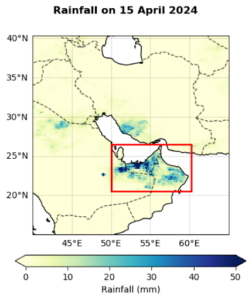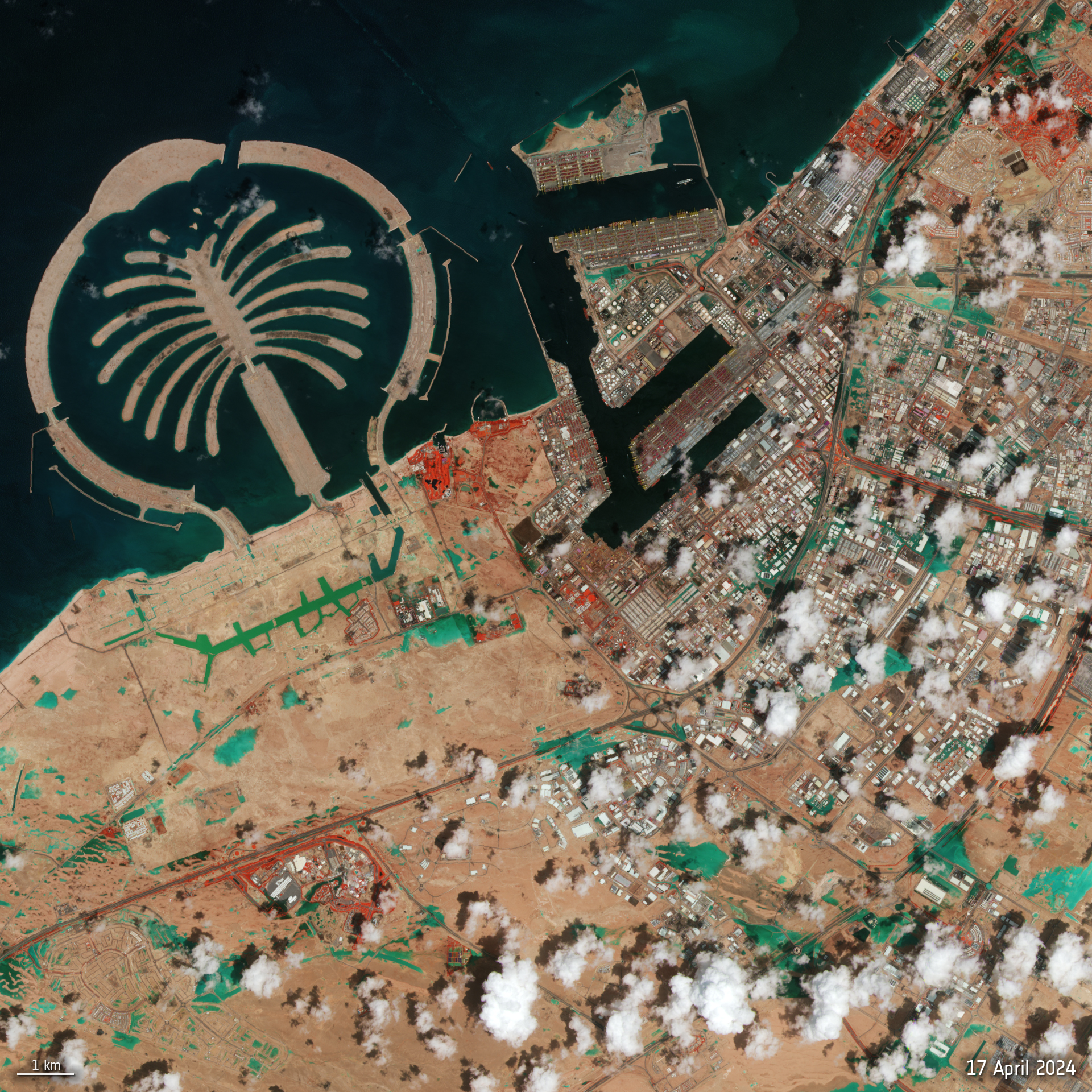The extreme rainfall event was associated with a low-pressure system, initially originating from mid latitude Eastern Europe, that induced violent storms, also bringing heavy rainfall to other parts of Asia.
In Dubai, most of the rain fell on Monday 15th of April and exceeded all previous records of daily rainfall in the last 75 years, when records began (UAE government, 2024).
Researchers from Saudi Arabia, Pakistan, Switzerland, the Netherlands, Sweden, the United States, Canada, France and the United Kingdom collaborated to assess to what extent human-induced climate change altered the likelihood and intensity of the weather conditions at the time of the most impactful floods.
To characterise the event we focus on daily maximum precipitation (RX1day). As this event was the highest on record we also looked at the annual maximum, which usually falls within this season. Using this RX1day variable has the additional advantage that it is one of the routinely calculated indices in most climate projections, thus making it easy to compare our analysis with published literature.
For the spatial definition of the event we analysed the region that saw the biggest impacts during the 1-day heavy rainfall event, indicated by the red box in Figure 1. The region includes the UAE, the northern part of Oman, Bahrain and a small part of Saudi Arabia.

Main Findings
- The UAE, Oman and the wider analysed region are located in a so-called hyper-arid region, with on average very little rainfall but with very high variability from year to year. Thus heavy rainfall events such as the one analysed here occur very rarely, leading to short records of similar events which results in high uncertainty in the assessment.
- The El Niño Southern Oscillation, a naturally occurring climate phenomenon, was found to be important to explain the variability in the observed rainfall. Most previous heavy rainfall events in the area occurred during El Niño years.
- To assess the role of human-induced climate change we first estimate if there is a trend in the observations associated with the warming up until today of 1.2°C and find that there is a trend, making heavy rainfall such as observed more likely. Based on the observations, the event was 10-40% more intense than it would have been had it occurred in an El Nino year in a 1.2°C cooler climate.
- To further characterise and quantify the role of human-induced climate change we then also look at climate models with high enough resolution to capture precipitation over the comparably small study region. The available climate models do not consistently exhibit a trend even for the models that were evaluated to simulate rainfall in the region reasonably well. However there is high uncertainty in this finding, again, due to high year to year rainfall variability.
- Based on the IPCC AR6 assessment, which includes scientific literature available up to January 2021, there is “medium confidence” that heavy precipitation would be detectably larger in the Arabian Peninsula at about 1.5°C of global warming compared to pre-industrial climate conditions, which is close to the current level of global warming.
- The disagreement between model results and observations prevents us from concluding with certainty that human-induced climate change is the main driver making this event more likely. However, while multiple reasons could explain the absence of a trend in our model results, we have no alternative explanation for a trend in observations other than the expectation of heavy rainfall increasing in a warmer climate.
- While the heavy rainfall was well forecasted by national meteorological agencies, floodwaters led to a high number of deaths and extensive damages to homes, shops, offices and cars in the UAE and Oman. The majority of flood related deaths occurred when people were travelling, and many people in Dubai were forced to abandon their cars in floodwaters. The researchers say this suggests warnings may not have reached some people or were not specific enough to the impacts expected in particular regions.
- The high flood risk varies across demographics. In Oman and the UAE, 80 and 85% of the total populations, respectively, live in flood-prone and low-lying areas that are highly exposed. Because of various challenges to their abilities to respond to flood risk, particularly vulnerable groups tend to include older adults, individuals with disabilities, women with caregiving responsibilities, racial/ethnic minorities, migrant workers, and lower-income groups.
- Across both countries, a high degree of surfaces with limited permeability and absorptive capacity from urban developments, inadequate drainage and the hyper-arid soils exacerbate the risk and severity of flash floods.
- UAE and Oman adopt proactive disaster risk management strategies, with functional systems for early warning, early action, and emergency response to floods, along with long-term adaptation planning. However, reducing the high exposure to flood risk, more proactive urban planning and integration of impact-based forecasting in EWS are necessary to reduce impacts associated with similar events in the future.
- Finally, cloud seeding was reported to not have been implemented in the context of this event, and additionally even in case of implementation has no influence on the amount of atmospheric moisture available, which was the main anomalous variable preceding the precipitation event. Hence, we can conclude that cloud seeding had no significant influence in the event





